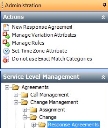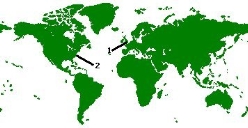Time zone associations
Time zones are managed using the Time Zone Index, which takes into account Daylight Saving Time. For example, the time zone (UTC-5.00) Eastern Time (US & Canada) adjusts for daylight saving changes, whereas the time zone (UTC-5.00): Bogota, Lima, Quito does not adjust for daylight saving changes, although it does have the same offset from UTC.
By default, the time zone for a Response Agreement (RA), Operational Level Agreement (OLA) or Underpinning Contract (UC) is associated with the calendar defined on the Response Level. This means that a Response Level’s escalation calculations are based on this time zone, irrespective of where the analyst, end-user or configuration items are.
You can, however, change this time zone association within Service Level Management. For example, you could add the Time Zone Name attribute to the Configuration Item window, and so associate a time zone with each individual configuration item. Then you could associate the time zone for an RA, OLA or UC with the time zone for the configuration items. This would mean that the Response Level’s escalation calculations would be based on the time zone set for the affected configuration items - so you would get different escalations calculated for a configuration item in New York from those for a configuration item in Hamburg, even if they were both logged against the same RA, OLA or UC in London.
For example, consider a configuration item that has been set to a time zone that is at UTC-5 and another configuration item that has been set to a time zone that is at UTC. The calendar associated with the OLA is set to start at 0900 and end at 1700, and the time zone for the OLA is associated with the time zone for the configuration item. Two incidents are logged at the same time for both configuration items, at 0900 UTC.
- LONDON UTC - Support hours 0900 to 1700
- NEW YORK UTC-5 - Support hours 0900 to 1700 (1400 to 2200 GMT)
For the Server at UTC, the one hour escalation is at UTC = 1000; for the Server at UTC-5, the escalation calculation does not start until the local time is 0900 (1400 UTC), therefore the first escalation for this server is at 1500 UTC, or 1000 local time. Both escalations are at the same local time (1000), but not at the same time in UTC.
Alternatively, you could associate the time zone for the OLA with the time zone for the calendar defined on the Response Level, and set that time zone to UTC. In this case, the first escalation for both incidents would occur at 1000 UTC (0500 local time for the server in New York).
In addition, you can specify that a specific time zone is used for specific users, analysts, customers and so on. You can add a time zone attribute to any business object that is used in conjunction with response agreements. This attribute will over rule the time zone that is defined in your calendars.
When you create this attribute, it must have a Data Type of String, and you will need to set a Sub Data Type property of Timezone. For more information about creating attributes, see the Designer Guide.
You can set the time zone association at the RA, OLA or UC top level only - you cannot have different time zone associations for different individual RAs, OLAs or UCs. For example, all Incident Assignment OLAs must have the same time zone association.
To change the time zone association:
- Start the Administration component.
- On the Service Level Management tree, expand the Agreements folder, then the relevant module.
- Expand the relevant Process or Assignment folder, and then select the relevant agreement type folder, for example, Response Agreements.

- On the Actions list, click Set Time Zone Attribute.
The Set Time Zone Attribute dialog appears. - On the Attributes tree, expand the required branch and click Time Zone Name.
The Selected Attribute field updates.
- Click OK.
The Time Zone for all Contracts, Operational Level Agreements or Response Agreements in that folder is associated with the selected attribute.
